The Orinoco Delta: Proven Ability
Part One
![]()
| LTA had started a run from Maturin to a “jungle” tourist lodge in the heart of the Delta Amacuro. Guayos is a Warao Indian village nestled along a river tributary flowing out to the furthest reaches of the Orinoco Delta proper. For the tourists the village represents life in a pure rainforest as well as being a historic location that dates back to Christopher Columbus. |
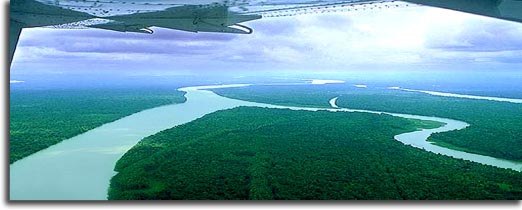
Back in 1997 LTA, or Linea Turistica Aereotuy, saw an opportunity to
expand their role as a purely tourist based air service into the oil
service industry with the upcoming oil development that was predicted to
take place in the Orinoco Delta. They did well in getting the first
private contract awarded by BP for the Caracas to Maturin schedule flight
in a Beech 1900. Their next step was to emulate the success of Pan African
Airlines in Nigeria and service BP with flights from Maturin to work
locations directly within the delta using the ecologically friendly Cessna
C208 Caravan amphibious seaplane. All looked rosy, except LTA had not
completed their homework.
After buying the factory new Caravan and having
it outfitted with Wipaire amphib floats and bringing it all the way to
Venezuela, they realized that BP was not about to award any contract to a
company that offered a single engine aircraft. Never mind that stodgy old
BP was still confusing twin piston-engine fiction with modern turbine
facts.
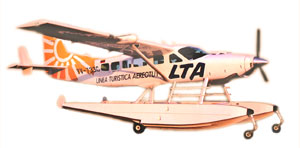 Consequently, when I arrived in Caracas 1997,
with the instructions to check out their floatplane pilots, LTA was
without a contract, and feeling a little dejected I might add. Their
amphib Caravan felt about as useful to them as if it were stranded in the
middle of the Sahara desert.
Consequently, when I arrived in Caracas 1997,
with the instructions to check out their floatplane pilots, LTA was
without a contract, and feeling a little dejected I might add. Their
amphib Caravan felt about as useful to them as if it were stranded in the
middle of the Sahara desert.
I could see, however, that they were trying
to make up for the disappointment of not being able to work the Caravan on
a BP contract. In addition to using the amphib to supplement the Grand
Caravans on the airport-to-airport tourist runs to Margarita Island, they
had started a run from Maturin to a “jungle” tourist lodge in the
heart of the Delta Amacuro. Guayos is a Warao Indian village nestled along
a river tributary flowing out to the furthest reaches of the Orinoco Delta
proper. For the tourists the village represents life in the rainforest as
well as being a historic location that dates back to Christopher Columbus.
The associated lodge was too small, however, to sustain a Caravan and I
felt it would be up to me to find more work for the unique aircraft.
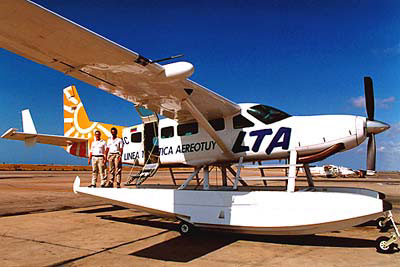 On my first workday I was to accompany Captain Garcias and his co-pilot
Gamboa along with the marketing manager to Guayos. The General Manager
asked me whether I wanted to fly, ride in the copilot seat, or just
observe. Of course I wanted to fly, but I checked my enthusiasm and
replied that I would do well to observe. After all, I reasoned, the pilots
had been to Flight Safety, they had gotten their floatplane ratings in
Florida, and they had been flying the aircraft for about a month now, with
several trips to Guayos under their belts.
On my first workday I was to accompany Captain Garcias and his co-pilot
Gamboa along with the marketing manager to Guayos. The General Manager
asked me whether I wanted to fly, ride in the copilot seat, or just
observe. Of course I wanted to fly, but I checked my enthusiasm and
replied that I would do well to observe. After all, I reasoned, the pilots
had been to Flight Safety, they had gotten their floatplane ratings in
Florida, and they had been flying the aircraft for about a month now, with
several trips to Guayos under their belts.
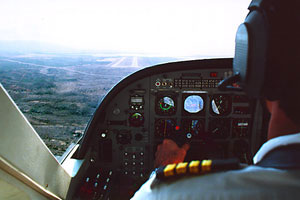 We left Maiquetia, Caracas’s International Airport, and landed at
Porlamar on Margarita Island. On our first landing a statement one of the
engineers had made to me when I questioned him about the maintenance came
back to me. He had said that other than the fact they were tearing through
tires, the aircraft was standing up very well. I remembered this as the
Captain landed squarely pegged at 120 kias with no flaps. The tires
screeched as we touched and left a trail of black rubber and smoke. I also
remember the GM telling me proudly that they only hired the most
experienced pilots, and in fact, Garcias was a 727 captain who had just
recently joined LTA. That explained the 727-style landing in the Caravan.
In a 727 if there is no smoke there is no landing.
We left Maiquetia, Caracas’s International Airport, and landed at
Porlamar on Margarita Island. On our first landing a statement one of the
engineers had made to me when I questioned him about the maintenance came
back to me. He had said that other than the fact they were tearing through
tires, the aircraft was standing up very well. I remembered this as the
Captain landed squarely pegged at 120 kias with no flaps. The tires
screeched as we touched and left a trail of black rubber and smoke. I also
remember the GM telling me proudly that they only hired the most
experienced pilots, and in fact, Garcias was a 727 captain who had just
recently joined LTA. That explained the 727-style landing in the Caravan.
In a 727 if there is no smoke there is no landing.
Next stop was the rainforest. As they climbed to
5500 ft ASL I could see the pilots getting visibly nervous as we left the
protected airspace and crossed over to the unbroken rainforest canopy of
the Orinoco Delta. When the last airfield fell behind us they climbed to
7500 ft, just to be sure. Deeper in the delta, there were no rain clouds
around and the visibility was decent, we flew over a layer of low broken
stratus, which really shook up the two pilots. They looked back at me and
I smiled. I could see the layer continued about 30 miles up and would end
before we reached our destination. That was enough to reassure them to
continue.
On reaching our rainforest lodge we made a low
and over as to warn the residents to prepare the canoe. The lodge had
placed an orange marker buoy on a line attached to an anchor for mooring
the aircraft. Garcias made several passes and then a long slow approach. I
was relieved to see that he was using 200 of flaps and was
willing to slow down to 95 kias. His water landing was smooth enough but
he careened slightly after touchdown. He over corrected the veer, but
managed to hang in until the aircraft fell off the step. I could see that
he was shaking. Not a good sign, but one I have seen in new floatplane
pilots before.
He approached the buoy from upstream and into the
wind. I could see the current was stronger than the wind, but he did not
seem to notice. He approached from the pilot side and the co-pilot did
nothing to assist. The delta native who was instructed to catch the
aircraft was tied to the buoy waiting in his canoe. I was very
uncomfortable with this arrangement, but apparently they had done this
before, so I did not interfere. As we came closer he feather the prop and
we proceeded to surge and glide quickly past the buoy.
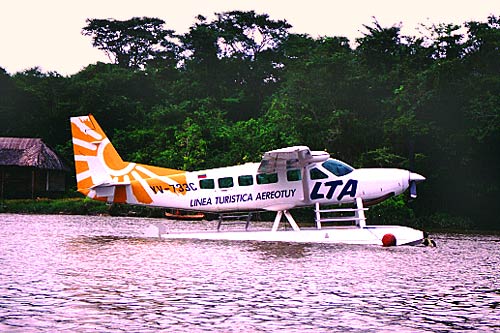
Garcias tried a panic turn, but with
little thrust and moving down current we had little leverage on the water
rudders. The aircraft ended up sideways in the narrow river still in
feather. He added power, but then realized we were still in feather. So he
pushed the prop forward and added power. As the aircraft came out of
feather it surged forward toward the bush lined shore. I wasn’t too
worried because all he had to do was use beta to get himself out of
trouble, even though, from my experience, if you need to use reverse to
extricate yourself out of a predicament then you have already messed up.
But, instead he decided, in a hurry of pure
panic, to feather the prop once more. As the prop surge and exhaust thrust
propelled us closer to the shore, I could see my training career in
Venezuela ending before it began as I sat helplessly in the center second
seat. In his non-thinking mode Garcias tried to jam in reverse, but to no
effect as the prop was feathered. As we were about to chop the greenery
into salad, I jumped out of my seat, thrust the power lever into idle,
threw the prop into full fine, hit the high idle, and yelled, “right
rudder, right rudder.” Although the Caravan turns more readily left in a
tight situation, we were already facing more right than left leaving me no
choice. Plus we would be turning into the current giving our rudders more
leverage. The prop slowly and agonizingly come out of feather, and then
quickly bit using the high idle. Finally, the big floatplane turned. Our
left wingtip brushed the leaves, but we made it around.
I waved the captain out his seat, and took over.
I then waved the Indian in the canoe away, and instructed the co-pilot to
get on the left float to observe. Then I swung the Caravan into the
current, approached the buoy using beta, and come to a standstill with the
left float bollard adjacent to the buoy. I then shut down in beta, quickly
jumped down on the float, slipped the buoy rope loop over the float
bollard, and then jumped back in to complete the shutdown procedures. When
the prop had lost momentum I feathered her finally to bring the big Cessna
to a safe stop.
The passengers cheered and the Venezuelan Captain
would not fly for the rest of the day. I did not mean to embarrass him,
but the result was the same. Although he very timidly accepted my follow
up float plane training, he had already made up his mind that risking his
727 airline career playing around in the water was not for him. He had
taken the job thinking compared to a 727, “how hard could it be?” and
found out it was much harder. In float flying the work only begins once
you land. The flying is easy. Any pilot can do that. He resigned a short
time later rather than risk turning his career into a tossed green salad.
After, back in Caracas, I talked to the GM and we
decided that I should come back as soon as possible to start training
several new pilots afresh. Luckily the co-pilot, Gamboa, decided to stay
and he was able to better prepare the two new pilots for my arrival. I
gave him some hard and fast rules to apply when flying the amphib Caravan,
and he passed this on.

Article and Images by John S Goulet
![]()
The attitude indicator will guide you back to Knowledge Based Stories.
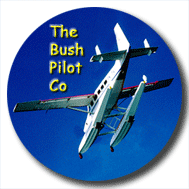 Top of this story.
Top of this story.
Last modified on
March 05, 2006 .
© Virtual Horizons, 1996.